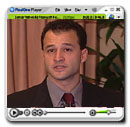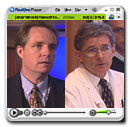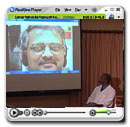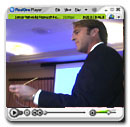Calit2 Teams with Stroke Center to Enable Remote Evaluation of Potential Stroke Victims
June 5, 2003 / By Doug Ramsey
Engineers and Medical Doctors Team in Unusual Collaboration to Apply Integrated Wireless and Video Technologies to Evaluate Potential Stroke Victims in Time to Enhance Their Life Outcomes – and in Larger Numbers |
|
Dr. Brett Meyer, co-director of the UCSD Stroke Center, announces the $5 million, 5-year award and talks about the scope of the SPOTRIAS project. 5:05 [Video]
|
6.5.2003 -- Pioneering techniques to extend time-critical treatment to potential stroke patients - in larger numbers and to remote locations - will begin at the University of California, San Diego (UCSD), Stroke Center with a $5-million, 5-year grant from the National Institute of Neurological Diseases and Stroke (NINDS) called the Specialized Program Of Translational Research In Acute Stroke (SPOTRIAS).
Through a collaboration involving the California Institute for Telecommunications and Information Technology [Calit²], the UCSD Jacobs School of Engineering, and the UCSD Stroke Center, physicians today demonstrated the ability to evaluate potential stroke victims remotely. What's significant about this is that now, by integrating and enhancing a set of telecommunications and information technologies, the limited number of stroke specialists can use their time much more efficiently to enhance the life outcomes of a much larger number of potential stroke victims, not only in San Diego but in areas reached by wireless technologies.
"We are delighted that this project provided an opportunity to not only piece together state-of-the-art technologies from Calit² industrial partners," says Ramesh Rao, "but also to enhance them in a unique way to provide a solution that satisfied the needs of this project. We are convinced that what we have learned from this experience is more broadly applicable." Rao, Calit² UCSD Division Director and a professor of Electrical and Computer Engineering in the Jacobs School, played a leading role in organizing this collaboration. He adds that not only do Calit² industrial partners provide funds to support research projects and student fellowships, but they also work with faculty members to integrate their technologies with those of other partners to create new capabilities.
 |
|
UCSD Stroke Center director Dr. Patrick Lyden and San Diego Emergency Medical Services director Dr. James Dunford comment on the cutting-edge technologies. 1:36 [Video]
|
This Multi-Media Telemedical Diagnostic System, as this capability is known, integrates expertise and advanced technologies in three areas - video processing, real-time cellular packet-data transport, and medicine. The prototype system provides an emergency room or clinic with access to medical specialists in other locations by means of a common-place personal laptop computer connected to the Internet via conditioned last-mile access loops and next-generation QUALCOMM cdma2000 EV-DO cellular data transport technologies. The system combines advanced video compression and synchronization technologies from Path 1 Network Technologies Inc. (OTCBB: PNWK), new technologies to guarantee the quality of service (QoS) for real-time video and medical telemetry over IP networks, and new mobile wireless data communications technologies. The unique innovations necessary to adapt the technologies to the project include improvement of the wireless QoS mechanisms to help ensure the quality of the video feed to the physician so as to enable correct diagnosis.
"The projects at UCSD will go a long way to take acute stroke treatment out to more patients. Dr. Patrick Lyden and UCSD colleagues will find ways to widen the window of opportunity for therapy, extend a helping hand to community hospitals and improve emergency diagnostic procedures," said Mary Ellen Michel, Ph.D., NINDS program director for the project.
Lyden, director of the UCSD Stroke Center and principal investigator of the grant, notes that time is critical in stroke treatment. Every 53 seconds in America, someone has a stroke, interrupting blood flow to the brain. Chances of recovery are significantly improved if treatment begins within three hours of stroke onset, but too many strokes result in death or severe disability due to delays in diagnosis and treatment.
 |
|
Dr. Meyer and Ramesh Rao, UCSD Division Director of Calit², demonstrate wireless Internet video technology that will permit long-distance, real-time exams of possible stroke victims. 5:22 [Video]
|
Only 30 percent of stroke victims arrive at the hospital in time to be considered as candidates for an effective type of clot-busting therapy called thrombolysis. Of these patients, about 20 percent actually receive the therapy, often because physicians are unsure if the patient is an appropriate candidate for the treatment.
Long-distance Consultation
Several community hospitals are expected to participate in a UCSD clinical trial that utilizes this enhanced, broadband wireless Internet technology. When a suspected stroke patient arrives in the emergency room, the local physician will send live video of the patient to a wireless, laptop computer operated by the on-call m ember of the UCSD stroke team. The UCSD stroke specialist participates in the physical exam as it takes place, consults with the community physician, and advises in administration of appropriate drugs.
Ultrasound Diagnosis
To aid in timely stroke diagnosis, UCSD will also investigate the use of contrast-enhanced ultrasound (CE-US) in a 288-patient clinical trial. This non-invasive test is administered at the bedside to measure obstruction in blood vessels. The investigators believe that CE-US will provide physicians with immediate feedback to determine if the patient is an appropriate candidate for thrombolytic therapy.
Brain Cooling
The grant will also support the use of a new ultrasound screening tool and clinical trials using hypothermia - cooling of the brain - as a method to extend the window of treatment effectiveness from three to six hours following stroke onset.
 |
|
INNERCOOL Therapies director of marketing Brad Klos demontrates brain-cooling intravascular catheter technology to be used in the trials. 1:30 [Video]
|
"While these projects will aid early identification of stroke patients, we would also like to extend the window for therapeutic intervention after acute ischemic stroke beyond the current three-hour limit," Lyden said. "We may be able to obtain the extra time with hypothermia. Cooling the brain could preserve brain cells longer, allowing us to administer thrombolytic therapy up to six hours after stroke onset."
Noting that surface cooling techniques such as ice water baths and air-cooled blankets cause complications and fail to adequately cool patients, Lyden is utilizing INNERCOOL Therapies' catheter technology that allows intravascular cooling methods. The catheters reside in the inferior vena cava and exchange heat with the patient's blood, while pharmacological agents and surface warming blankets lower the patient's thermoregulatory responses to prevent shivering.
Additional information:
Calit², one of four institutes established through the California Institutes for Science and Innovation initiative from Governor Gray Davis' office in 2000, seeks to extend the reach of the Internet throughout the physical world. Calit² teams faculty, students, and research professionals from UCSD and UCI with scientists and engineers from leading California companies to investigate how this future Internet will accelerate advances in environmental science, civil infrastructure, intelligent transportation and telematics, genomic medicine, the new media arts, and educational practices. Calit² provides students early opportunities to work in teams with technologists and practitioners in real-world environments, and engages with large and startup companies to field test emerging commercial ideas as part of larger-scale projects.
UCSD Stroke Center
The UCSD Stroke Center has been recognized by the University HealthSystem Consortium (UHC) as one of the nation's top academic medical centers providing stroke treatment. In a nationwide survey of 33 academic medical centers and 1,227 patients, the UCSD Stroke Center ranked second overall, measured against a variety of clinical benchmarks, including complication and death rates, length of hospitalization, diagnostic tests, and health counseling prior to discharge. Recently, the UCSD Stroke Center was selected by NINDS as the site for production of a national DVD to train medical professionals to in the use of the NIH Stroke Scale. Lyden was named lead medical advisor for the NINDS DVD project, which included two weeks of filming in February at UCSD Medical Center in Hillcrest and on the UCSD campus in La Jolla. In addition to its strong research and clinical components, the UCSD Stroke Center trains the next generation of stroke specialists in a Stroke and Vascular Neurology program that offers two physician fellowships each year.
NINDS, a division of the National Institutes of Health, at the Department of Health and Human Services, launched the SPOTRIAS program in an effort to develop and offer more rapid diagnosis and clinical treatments to acute stroke patients. UCSD is the third SPOTRIAS program to be funded, joining the University of Texas Medical School at Houston and the University of Cincinnati. NINDS plans to fund a total of 10 SPOTRIAS grants over the next three years.
INNERCOOL
INNERCOOL was co-founded in 1998 by John Dobak, M.D., the company's president and CEO and an alumnus of the UCSD School of Medicine, and Juan Lasheras, chair of Mechanical and Aerospace Engineering at the UCSD Jacobs School.
The Celsius Control SystemT consists of an endovascular catheter, console and proprietary disposables. The distal portion of the catheter incorporates a flexible Temperature Control Element (TCE) that is cooled or warmed with saline solution circulated in a closed-loop manner from the console. When placed in the inferior vena cava, the TCE exchanges thermal energy directly with the blood, resulting in cooling or warming of the downstream organs and body. The Celsius Control System does not infuse fluid into the patient, nor is blood circulated outside of the body.
INNERCOOL received FDA clearance in January 2003 for the Celsius Control System to induce, maintain and reverse mild hypothermia in neurosurgical patients in surgery and recovery/intensive care.
Media Contacts
California Institute for Telecommunications and Information Technology [Calit²] Stephanie Sides, 858-534-5131, ssides@ucsd.edu
UCSD Jacobs School of Engineering Denine Hagen, 858-534-2920, dhagen@ucsd.edu
UCSD Stroke Center/UCSD School of Medicine Sue Pondrom, 619-543-6163, spondrom@ucsd.edu

